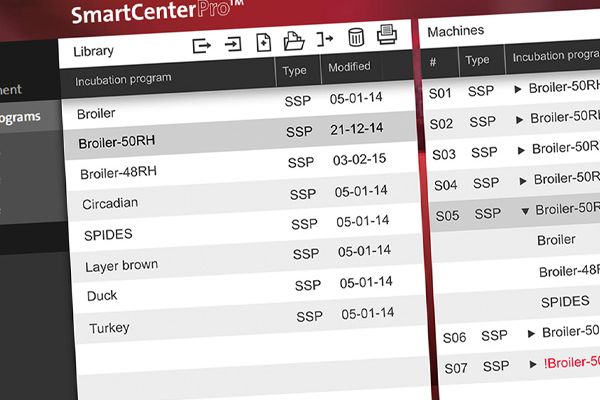Limit your programme library
Tags: Hatchery management | Whitepaper
, April 20 2022

A contemporary hatchery is usually a big installation with many setters that are controlled by a specialized computer. This computer can have numerous functions. For example, it can store data on activities related to the entire hatchery operation, such as climate, service, maintenance and turnover of eggs and chicks, and it can monitor the functioning of all the installed equipment, failures and alarms. An important part of the computer is the programme library, which contains a set of incubation programmes.
The basic incubation programmes supplied by the incubator manufacturer provide a safe framework to start with. Note that – however successful it is – an incubation programme from a neighbour using the same brand of incubators cannot be simply transferred and applied. The incubation programme must be designed based on the specific, local conditions, such as the brand and type of machines, details of their installation (piping, air supply system), climate (winter/summer, rainy/dry), altitude, duration and conditions of egg storage, breed and age of the flock, egg size, and even a flock’s health status. All of these factors may require different programmes. So, although the potential offered by computers is highly appealing – a new version of an incubation programme can be prepared quickly and the programme library can contain an unlimited list of programmes for all possible situations – this list needs to be kept within certain limits.
A big hatchery usually operates based on what it receives from the large egg suppliers. The average breeder farm size has increased substantially over the years, and in some cases a single flock can count as many as 100,000 hens or more. As a consequence, hatcheries may receive large, uniform batches of eggs for entire setters. Moreover, modern technology allows the mechanical grading of eggs that are produced by the same flock, which can also increase the uniformity of the load. Large, uniform batches of eggs collected within a short time create an ideal situation for applying batch-specific incubation programmes. This is in contrast to the situation in which setters loaded with a mix of eggs of different characteristics require an incubation programme that benefits the average egg. Furthermore, by controlling the internal climate and air supply parameters, the hatchery is less dependent on the seasons and prevailing weather conditions. Under normal conditions, therefore, a limited number of programme variants is required.
Even if an incubation programme has been proven to lead to excellent results, it cannot be considered as a final, fixed version. New, corrected variants will need to be created, but it makes sense to store the old versions until the new one has proved itself. This process gradually extends the programme library.
In the day-to-day operation of a large hatchery, eggs of different types will be loaded to different machines. Using the various incubation programmes requires good administration to ensure that the right programme is consistently used for the right type of eggs. However, this is not always easy in a hatchery with many setters: as is often seen in the contemporary poultry business.
Advice:
- Develop a basic, standard incubation programme for your hatchery for the average situation, egg type and local technical conditions. Use this programme for all ‘normal’ settings.
- Monitor eggshell temperature and egg weight loss so that corrections can be made.
- Prepare a few variants for specific situations such as long storage, old and young flocks, and different seasons, if they have a big impact on the climate conditions.
- Give the programmes clear names for easy identification of their purpose and creation date.
- Limit the number of programmes being used.